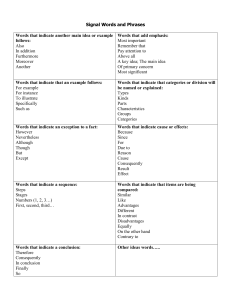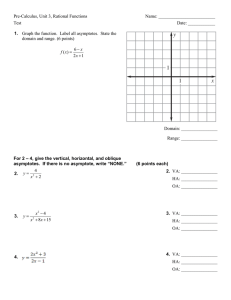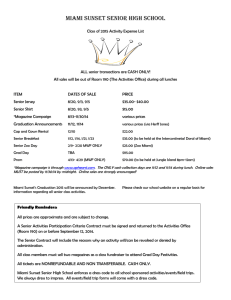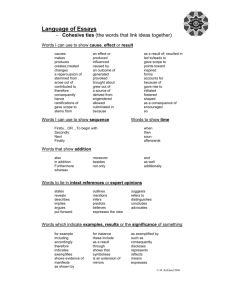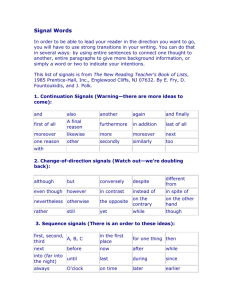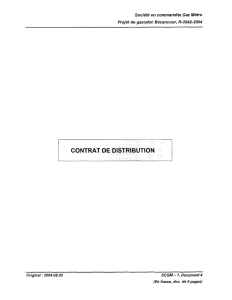7.1. Probability that a person is subscribed to at least one... is equal to 0.6 + 0.4 − 0.3 = 0.7....
advertisement
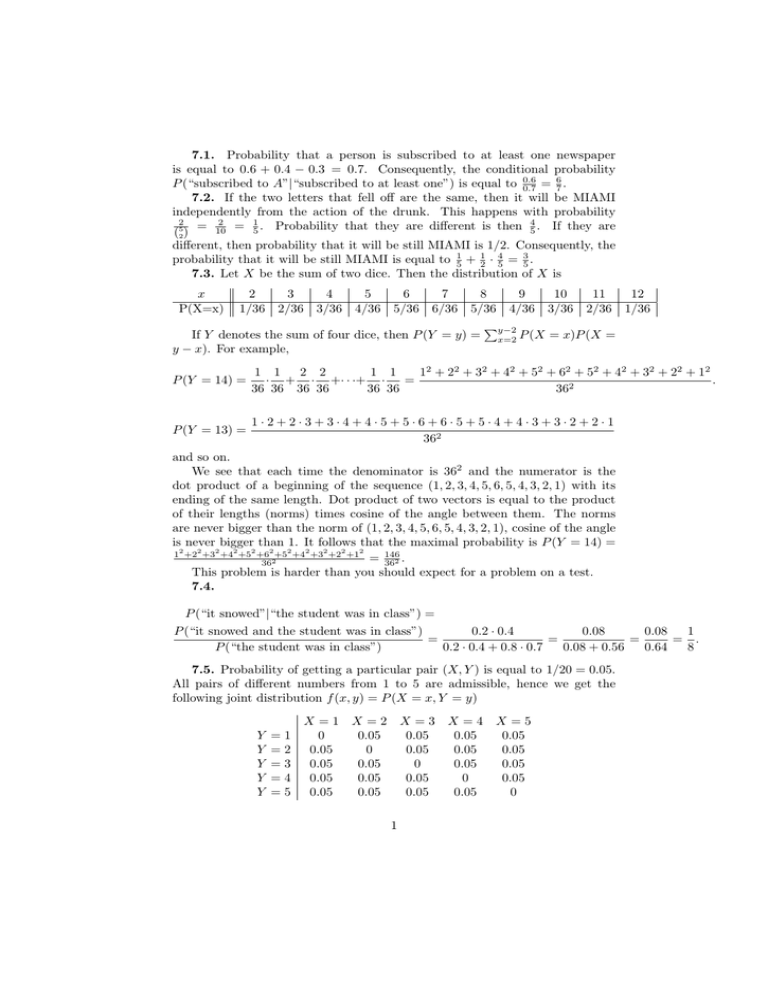
7.1. Probability that a person is subscribed to at least one newspaper is equal to 0.6 + 0.4 − 0.3 = 0.7. Consequently, the conditional probability 0.6 = 67 . P (“subscribed to A”|“subscribed to at least one”) is equal to 0.7 7.2. If the two letters that fell off are the same, then it will be MIAMI independently from the action of the drunk. This happens with probability 2 2 = 10 = 15 . Probability that they are different is then 54 . If they are (52) different, then probability that it will be still MIAMI is 1/2. Consequently, the probability that it will be still MIAMI is equal to 15 + 12 · 45 = 53 . 7.3. Let X be the sum of two dice. Then the distribution of X is 5 6 7 8 9 10 11 12 4/36 5/36 6/36 5/36 4/36 3/36 2/36 1/36 Py−2 If Y denotes the sum of four dice, then P (Y = y) = x=2 P (X = x)P (X = y − x). For example, x P(X=x) 2 1/36 3 2/36 4 3/36 P (Y = 14) = 1 1 2 2 1 1 12 + 22 + 32 + 42 + 52 + 62 + 52 + 42 + 32 + 22 + 12 . · + · +· · ·+ · = 36 36 36 36 36 36 362 P (Y = 13) = 1·2+2·3+3·4+4·5+5·6+6·5+5·4+4·3+3·2+2·1 362 and so on. We see that each time the denominator is 362 and the numerator is the dot product of a beginning of the sequence (1, 2, 3, 4, 5, 6, 5, 4, 3, 2, 1) with its ending of the same length. Dot product of two vectors is equal to the product of their lengths (norms) times cosine of the angle between them. The norms are never bigger than the norm of (1, 2, 3, 4, 5, 6, 5, 4, 3, 2, 1), cosine of the angle is never bigger than 1. It follows that the maximal probability is P (Y = 14) = 12 +22 +32 +42 +52 +62 +52 +42 +32 +22 +12 = 146 362 362 . This problem is harder than you should expect for a problem on a test. 7.4. P (“it snowed”|“the student was in class”) = P (“it snowed and the student was in class”) 0.2 · 0.4 0.08 0.08 1 = = = = . P (“the student was in class”) 0.2 · 0.4 + 0.8 · 0.7 0.08 + 0.56 0.64 8 7.5. Probability of getting a particular pair (X, Y ) is equal to 1/20 = 0.05. All pairs of different numbers from 1 to 5 are admissible, hence we get the following joint distribution f (x, y) = P (X = x, Y = y) Y Y Y Y Y =1 =2 =3 =4 =5 X=1 X=2 X=3 X=4 X=5 0 0.05 0.05 0.05 0.05 0.05 0 0.05 0.05 0.05 0.05 0.05 0 0.05 0.05 0.05 0.05 0.05 0 0.05 0.05 0.05 0.05 0.05 0 1 R3 7.6. We must have 1 = 0 cx2 dx, i.e., 1 = 3c x3 |30 = 3c · 33 = 9c. Hence c = 1/9. R3 Then EX = 0 x · x2 /9 dx = x4 /36|30 = 9/4. R 3 EX 2 = 0 x2 · x2 /9 dx = x5 /45|30 = 27/5. And var(X) = EX 2 − (EX)2 = 81 1 3 27 27 5 − 16 = 27 · 5 − 16 R= 80 . 3 1.5 2 1 1.53 7.7. P (X < 1.5) = 0 x /9 dx = x27 |1.5 0 = 27 = 8 . R3 2 3 3 19 −2 = 27 . P (X > 2) = 2 x /9 dx = 3 27 k −λ λ 7.8. P (X = k) = e k! . So, P (X = 0) = e−λ = e− ln 2 = 1/2. If m < 0, then P (X ≤ m) = 0 < 1/2. If m > 1, then P (X ≥ m) ≤ P (X ≥ 2) < 1/2. On the other hand, if 0 < m ≤ 1, then P (X ≥ m) = P (X ≥ 1) = 1/2. If m = 0, then P (X ≥ m) = P (X ≥ 0) = 1. If 0 ≤ m < 1, then P (X ≤ m) = P (X = 0) = 1/2. If m = 1, then P (X ≤ m) > 1/2. It follows that for every m ∈ [0, 1] we have P (X ≥ m) ≥ 1/2 and P (X ≤ m) ≥ 1/2. Consequently, the medians are the numbers in the interval [0, 1]. 7.9. This problem is not covered on exam, since independent continuous random variables were not studied yet. I will leave it for a future homework. Sorry. . . 2
